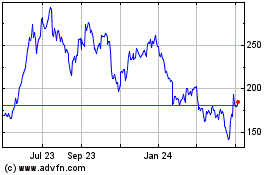By Tim Higgins
Tesla Inc. marks the beginning of a new era this week: the loss
of a U.S. tax credit that effectively lowered the price of its
vehicles and helped build interest in fledgling electric cars.
The end of the U.S. tax credit on Jan. 1 for the company's
customers comes as Tesla's future growth increasingly looks tied to
China, where it began this week delivering the first of its locally
made Model 3 compact cars.
China, the world's largest new-car market, is becoming important
in Chief Executive Elon Musk's strategy for remaking the Silicon
Valley auto maker into a global player with ambitions of selling
millions of electric vehicles a year. China is already one of
Tesla's biggest markets, and the car maker has said it could become
the largest for the Model 3.
"This is a changing of the guard, as the U.S. tax credit rolls
off and the major growth story for Tesla is moving from the U.S. to
China," said Dan Ives, analyst for Wedbush Securities.
Tesla didn't respond to requests for comment.
The U.S. remains critical to Tesla's near-term ambitions to
produce 500,000 vehicles within a year. The $7,500 U.S. tax credit
for buyers of its electric vehicles had been an important part of
its sales pitch to U.S. buyers.
"Your lips were always loaded with that," said Seneca Giese, a
former Tesla general manager who now runs a used electric-vehicle
sales business called Current Automotive. "It was certainly a
factor in Tesla's success, but I don't think it's going to affect
demand going forward," because the company has lowered the starting
price of its smaller Model 3 vehicle to about $35,000 from
$46,000.
The government introduced the tax break, passed in 2008, to help
offset the battery costs of electric vehicles and keep their prices
in line with comparable gas-powered cars. The credit, also
available to other car makers, is gradually withdrawn as a
manufacturer sells more electric vehicles. A last-ditch push by the
auto industry to extend a tax credit failed in December in
Congress.
For Tesla, the tax credit began to phase out a year ago, first
dropping to $3,750 before falling to $1,875 on July 1. It goes to
zero Jan. 1 because Tesla's total U.S. sales reached 200,000
vehicles during the third quarter of 2018, sunsetting the benefit.
General Motors Co. is the only other auto maker to reach the
milestone. Other manufacturers that haven't hit the limit can still
lure buyers with the government incentive.
The expiring tax credit spurred buyers such as 48-year-old
Carlos Santos of suburban Atlanta, who considered himself a
longtime BMW fan until he test-drove a Model 3 early this year.
"That tax credit, for us, was very important," Mr. Santos, who
works in the movie business, said.
Tesla lowered its prices as the tax credit faded, and the move
contributed to a rebound in the auto maker's deliveries after a
weak first quarter. The slow start rattled investors and put in
doubt whether Tesla could reach Mr. Musk's commitment to deliver
between 360,000 and 400,000 vehicles in 2019, an increase of at
least 47% from 2018.
With the rebound in deliveries, the auto maker needs at least
104,800 deliveries in the fourth quarter to reach the goal.
Analysts, on average, expect the company to announce 106,000
deliveries, according to FactSet. Tesla could release its
fourth-quarter delivery numbers this week.
The auto maker is expected to continue to face production
pressure in 2020. The company needs to churn out as many cars as it
can from its new China factory so customers there can take
advantage of a government subsidy granted only to locally built
electric vehicles. The incentive expires in 2020.
Tesla in December secured an agreement from a syndicate of
Chinese lenders to raise as much as $1.61 billion in borrowing for
the new facility, which broke ground in January and began trial
production in October -- an unusually quick turnaround. The first
15 China-made Model 3s were delivered to Tesla employees
Monday.
Tesla said it is able to produce more than 1,000 vehicles a week
at the facility. It aims to get to a rate of 3,000 a week in the
near future.
California-made Model 3s sold in China with a longer range have
a starting price of 439,900 ($62,861), while the locally assembled
version begins at 355,800 yuan ($50,844). The Chinese factory
allows Tesla to avoid tariffs and qualify for a 25,000-yuan subsidy
given to electric vehicles. The government has announced the
locally made Model 3 also will be exempt from a 10% consumption
tax.
The new factory also is destined to make Tesla's next vehicle,
the Model Y, a compact sport-utility vehicle that is slated to
begin production in the U.S. in 2020. The local introduction is
expected to fuel further Chinese growth.
Tesla's overall international growth has helped distract
attention from its slowing U.S. business, its largest market.
Third-quarter U.S. revenue declined 40% compared with a year
earlier. The auto maker doesn't break out vehicle deliveries in the
U.S. beyond disclosing revenue.
Sales in China and the Netherlands are expected to drive
deliveries in the October through December period, said Jeffrey
Osborne, analyst for Cowen & Co. Without those markets, he
estimated, overall deliveries would be down 7% from a year
earlier.
--Ben Foldy contributed to this article.
Write to Tim Higgins at Tim.Higgins@WSJ.com
(END) Dow Jones Newswires
December 31, 2019 11:55 ET (16:55 GMT)
Copyright (c) 2019 Dow Jones & Company, Inc.
Tesla (NASDAQ:TSLA)
Historical Stock Chart
From Mar 2024 to Apr 2024

Tesla (NASDAQ:TSLA)
Historical Stock Chart
From Apr 2023 to Apr 2024
